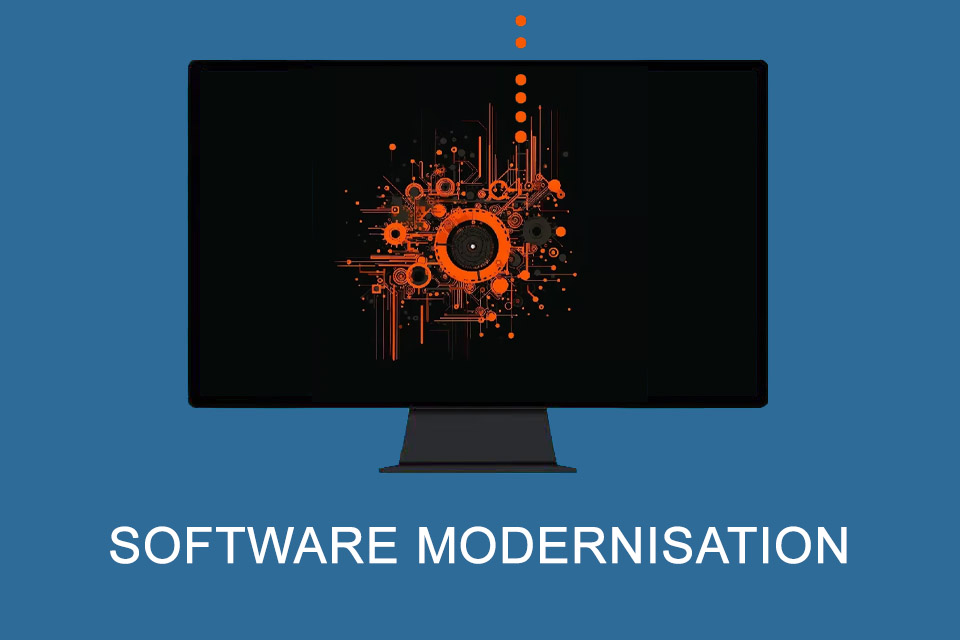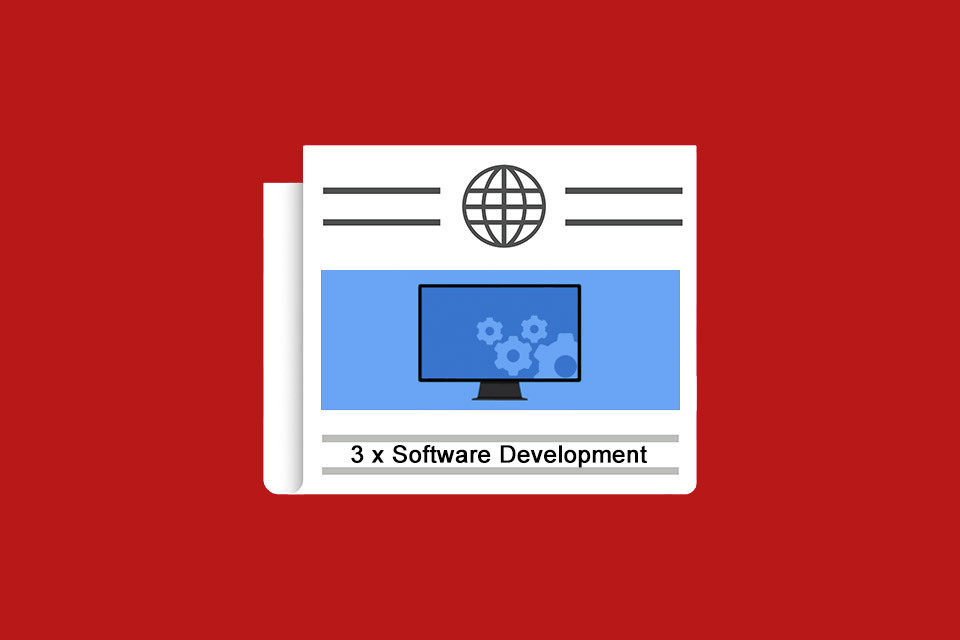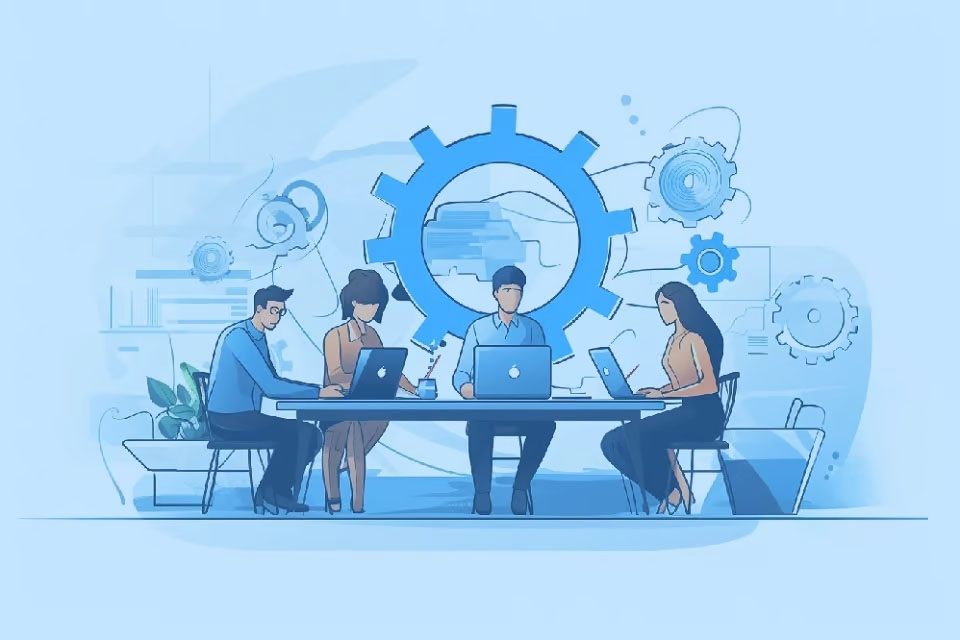What is a Software Modernisation?
Table of Contents: Definition – Reasons – Types – Procedure – Questions from the field – Notes
Software modernisation – an unavoidable task for organisations
Software ages and almost all software eventually reaches a point where it can no longer be further developed with the existing technology or only with a great deal of effort. However, the main goal of software development is to create useful software with little effort.¹ Therefore, organisations should consider modernising their software at this point at the latest.
Software modernisation means adapting the software to new requirements and technologies in order to improve its performance, security and user-friendliness, reduce costs and complexity and increase its service life, scalability and flexibility.
Reasons for the modernisation of software
There are a whole range of reasons for modernising software. Here is a selection:
- The existing software no longer fulfils current requirements and these are difficult to implement.
- The software is no longer or only partially compatible with more modern systems in the company.
- The existing software is based on outdated technology that is no longer being developed further.
- Licence or platform costs are significantly higher compared to the competition.
- The operating concept of the software is outdated, not standardised and consistent and does not offer any positive user experience.
- The application is based on legacy code that can only be removed with great effort.
- The performance of the application cannot be easily increased, e.g. because the application is not designed for large amounts of data or a high number of simultaneous user accesses.
- The operation of the application is no longer as stable as required and, for example, agreed with customers.
- The total technical debt is too high.
- Security gaps in old software are difficult or impossible to close.
- The loss of a long-standing programmer leads to a loss of knowledge that cannot be compensated for. Perhaps the number of software developers on the market with the relevant expertise is also declining and it is becoming increasingly difficult to recruit the right specialists.
In the practice of software development, it is also not uncommon for functioning code to be difficult to read, modify, extend and maintain. This is another reason for software modernisation.
Types of software modernisation
There are various ways in which software can be modernised²:
Refactoring refers to the restructuring of software while retaining its functionality, with the aim of increasing the performance of the software and facilitating further development. The goals are achieved by maintaining and improving the design, optimising the code, for example by using new, better, faster or more robust programming languages, libraries, widgets, etc. and eliminating code smells.
In reengineering, the existing software architecture and functionality is revised or redesigned in order to adapt it to current standards and requirements. A distinction is made between two forms: in “pure” reengineering, the system is merely reconstructed without adding functionality; in “extended” reengineering, the system is reconstructed in order to change existing functionality or add new functionality.
Migration involves transferring software from one platform or environment to another in order to make it compatible with new technologies or infrastructures. This may involve updating operating systems, databases or programming languages.
Virtualisation or containerisation involves running applications in virtualised environments or packaging them in containers, e.g. to improve their performance and scalability (and also their portability).
These different types – also referred to as software remediation in some publications – can be applied individually or in combination, depending on the specific requirements and objectives of a modernisation project.
There is also another option: complete redevelopment. This involves developing the existing software from scratch in order to replace outdated technologies with modern ones and to redesign the entire architecture of the software.
The procedure for software modernisation
The following procedure has proven to be useful in practice:
- Analysing the current status,
- strategy development including goal definition,
- selection of the appropriate type of modernisation and action planning,
- implementation of modernisation measures and
- evaluation and follow-up.
In terms of content, many additional points need to be weighed up:
- What exactly should be modernised, why and with what priority, and is there agreement on this between the key stakeholders?
- Are the requirements correct, complete, unambiguous, consistent, assessed in terms of importance and/or stability, verifiable and traceable?
- What is the relationship between the costs and benefits of modernisation?
- What time frame is available and what capacities are required? Can internal employees be utilised or is external support required? How will a service provider be selected?
- Is it a project? Who is involved, who takes responsibility, who makes decisions, how and when? What is the priority of the project in relation to other undertakings?
- What specific challenges need to be overcome?
- What will create the most value for the organisation in the short, medium and long term?
- How can employees be prepared for the changes and how can their acceptance be ensured? Are training courses or other measures required?
- What legal and security aspects need to be taken into account during modernisation, particularly with regard to data protection and compliance?
- How can it be ensured that the modernised software will also meet the requirements and developments in the company in the long term? What measures are required to make the software fit for the future?
The best approach to software modernisation is therefore likely to be one that answers these and similar questions at an early stage and uses the findings to proceed in a planned, targeted and, ideally, flexible manner.
Questions from the field
Here you will find some questions and answers from the field:
What are the goals of software modernisation?
- Improving software quality
- Increasing power and performance
- Increase security and data protection standards
- Adaptation to new business requirements and technologies
- Reducing complexity and maintenance costs
- Optimisation of the user experience
- Ensuring compatibility with modern systems
- Minimising operational risks and ensuring compliance
- Increasing the scalability and flexibility of the software
- Reducing the total cost of ownership
This list of goals can certainly be easily extended.
What is the difference between enhancing and modernising software?
The enhancement of software and software modernisation are two different concepts, but they can be linked:
Enhancement addresses the ongoing process of improving software after its original implementation. New features can be added, existing functions optimised and bugs fixed. Further development aims to continuously adapt the software to changing requirements and increase its value for users without necessarily fundamentally changing the underlying architecture or technology.
Modernisation refers to the redesign of existing software in order to adapt it to current requirements, technologies and standards. Various approaches such as refactoring, reengineering or new development can be used. The main goal of modernisation is to improve the performance, security, usability and scalability of the software while reducing complexity and operating costs.
The main difference, then, is that software modernisation is usually a more comprehensive and in-depth overhaul of the software, while enhancement tends to focus on incremental improvements and extensions to increase the value of the software over time.
What is the difference between software migration and software modernisation?
Software migration is a form of software modernisation and refers to the process of moving software from one environment to another while leaving the functionality largely unchanged. This can include moving from one platform to another, such as from one operating system to another, or from one database version to a newer version.
Modernisation refers to the redesign of existing software to adapt it to current requirements, technologies and standards. This can include improving the user experience, increasing security, optimising performance, simplifying maintenance and reducing costs over time.
Why are organisations reluctant to modernise software?
There are various reasons why organisations are reluctant to modernise their software: On the one hand, modernisation is not always easy, both technically and organisationally. On the one hand, modernisation is not always easy, both technically and organisationally.
Some organisations are also afraid of losing important data and/or changing their usual workflow. In addition, existing applications and systems offer familiarity and a certain level of comfort, which helps to manage familiar activities even when performance is low. The complexity of modernisation and concerns about the performance of new systems are also factors that make organisations hesitant.
What questions should be answered in the run-up to modernisation?
- Should the entire application be modernised or just certain components or features?
- Which technologies and frameworks are best suited? How well can the new technologies be integrated into the existing architecture?
- How will the data be transferred from the old to the new software environment? How will data integrity and consistency be ensured?
- How will user feedback be taken into account during the modernisation process? What training is required to ensure that users can make the best use of the new functions?
- How will the modernisation affect existing business processes and workflows? Are adjustments required in other departments? What financial resources are available for the modernisation? How will the return on investment (ROI) be measured?
To ensure that modernisation does not fail, organisations should be able to answer these and similar questions very accurately.
Why do software modernisations fail?
Software modernisations can fail for various reasons:
One main reason is the unclear definition of objectives. If the goals of the modernisation are not clearly defined or change during the process, this can lead to misunderstandings and conflicting objectives. Insufficient planning and analysis of the existing software and the requirements and risks of modernisation can also lead to unexpected problems and delays.
Another factor is the lack of resources. If there is not enough time, budget or qualified employees available for the modernisation, this can hinder implementation and jeopardise success. Resistance to change from employees or stakeholders can also make implementation more difficult and jeopardise success.
Technical challenges such as complex legacy systems, outdated technologies or insufficient documentation can make modernisation even more difficult. A lack of expertise in the area of software modernisation on the part of the internal team or insufficient external support can lead to errors and problems.
Insufficient communication between the parties involved, including stakeholders, developers and users, can lead to misunderstandings and misinterpretations that jeopardise success. Furthermore, insufficient testing and quality control during the modernisation process can lead to late-detected errors and costly corrections.
If an organisation overestimates its own capabilities and tackles overly complex or extensive modernisation projects, this can lead to overload, errors and misjudgements. Finally, a lack of support from senior management can also jeopardise success and hinder the process.
It is important to recognise and counteract these potential obstacles to software modernisation. A clear definition of objectives, thorough planning and analysis, sufficient resources, good communication and adequate testing and quality control are crucial to the success of such projects. It is also important to strengthen the expertise of the internal team or bring in external support to overcome technical challenges.
Management should actively support the modernisation process and ensure that the necessary resources are made available. This is the only way to ensure a successful software modernisation that increases an organisation’s efficiency and competitiveness.
When is the optimal point for an organisation to start modernising its software?
Notes:
If you like the article or would like to discuss it, please feel free to share it in your network. And if you have any comments, please do not hesitate to send us a message.
[1] Goals of software development (in German)
[2] In addition to the types mentioned above, rehosting, replatforming, rearchitecting or rewriting are also mentioned on the Internet. There are also several terms for one thing in software development.
The TIMETOACT GROUP has published a study on software modernisation in which it discusses the relevance for companies as well as problems, challenges and expectations (also in German).
And here you can find additional information from the t2informatik Blog:



